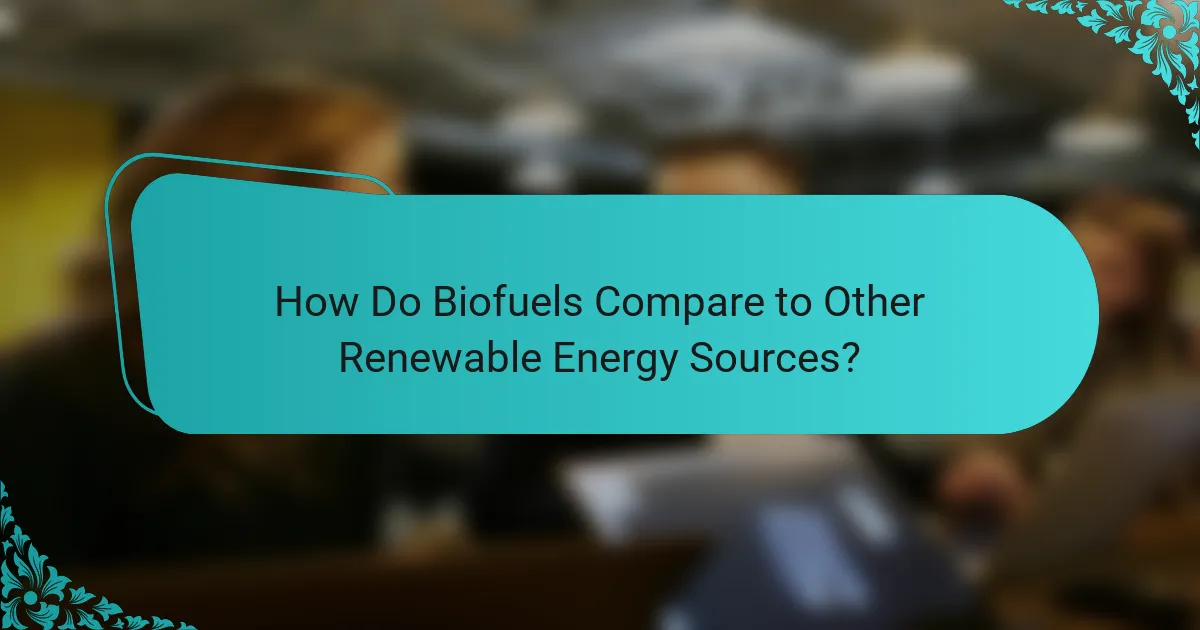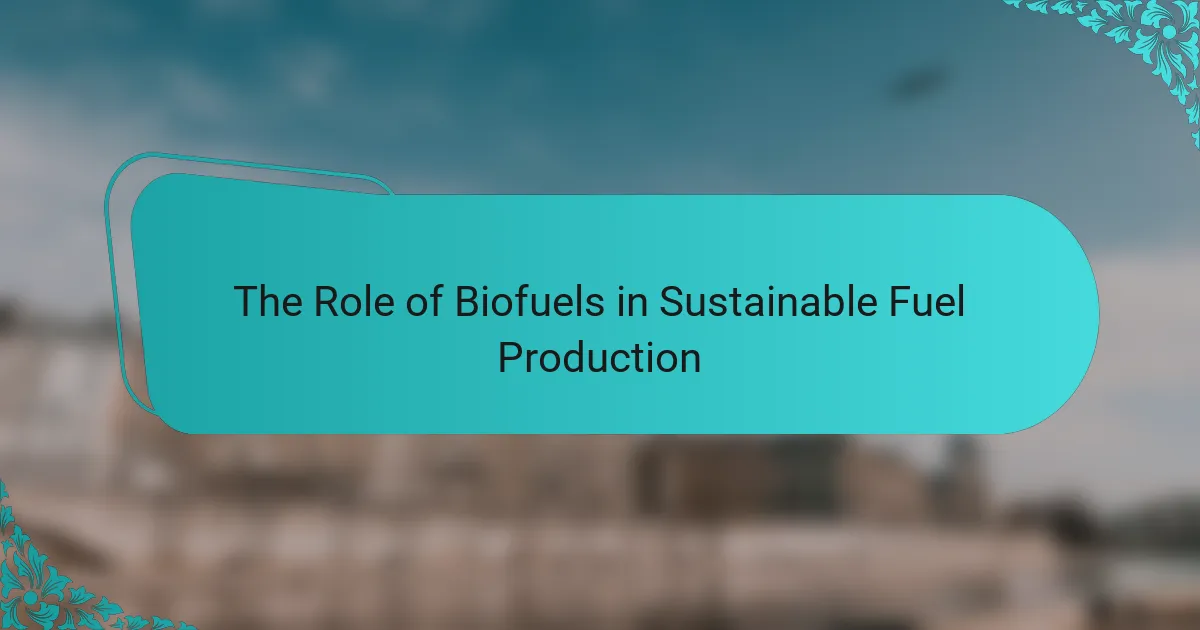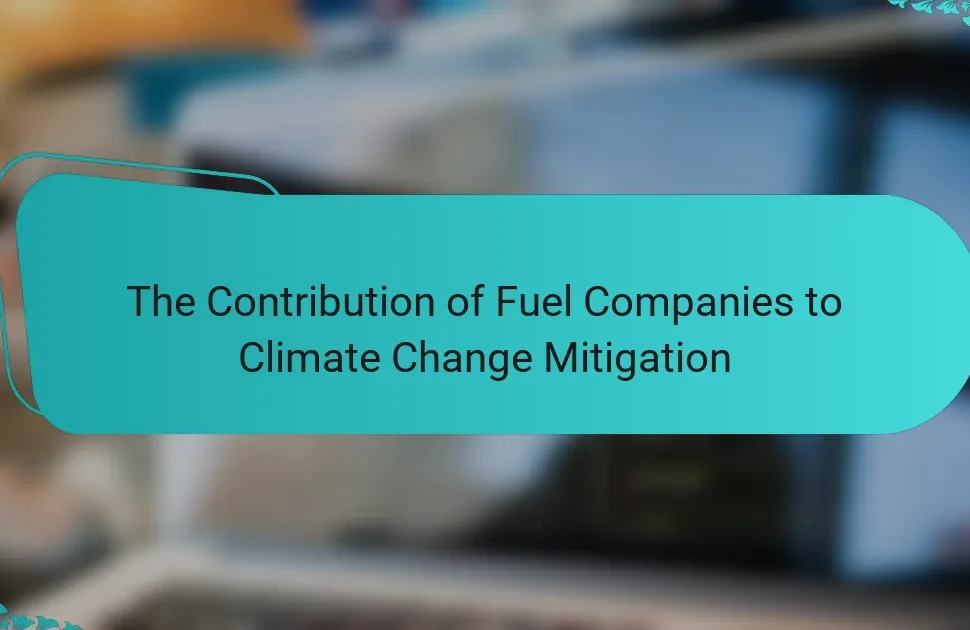
What are Biofuels and Their Role in Sustainable Fuel Production?
Biofuels are renewable energy sources derived from organic materials. They include ethanol from corn and biodiesel from vegetable oils. Biofuels play a significant role in sustainable fuel production by reducing greenhouse gas emissions. According to the U.S. Department of Energy, biofuels can lower carbon dioxide emissions by up to 86% compared to fossil fuels. They also promote energy independence by decreasing reliance on imported oil. Additionally, biofuels can utilize waste products, contributing to a circular economy. The use of biofuels supports agricultural economies by creating demand for crops. Overall, biofuels are a viable alternative to conventional fuels, promoting sustainability.
How are Biofuels Produced?
Biofuels are produced through the conversion of biological materials into energy sources. Common feedstocks include crops like corn, sugarcane, and soybeans. The production process typically involves fermentation or transesterification. In fermentation, sugars from feedstocks are converted into ethanol by yeast. Transesterification involves reacting fats or oils with an alcohol to produce biodiesel.
After production, biofuels are refined to meet specific fuel standards. The process often emits fewer greenhouse gases compared to fossil fuels. According to the U.S. Department of Energy, biofuels can reduce carbon emissions by up to 86% when produced sustainably. This makes them a crucial component in sustainable fuel production strategies.
What feedstocks are commonly used in biofuel production?
Common feedstocks used in biofuel production include corn, sugarcane, and soybeans. These crops are rich in carbohydrates or oils, making them suitable for conversion into biofuels. Corn is primarily used for ethanol production, while sugarcane is favored in regions like Brazil for its high sugar content. Soybeans are often processed into biodiesel due to their oil yield. Other feedstocks include canola, palm oil, and various types of agricultural waste. Agricultural waste, such as straw and husks, can also be converted into biofuels, providing an alternative to traditional crops. Each of these feedstocks contributes to the overall sustainability of biofuel production.
What processes are involved in converting feedstocks to biofuels?
The processes involved in converting feedstocks to biofuels include pretreatment, fermentation, and transesterification. Pretreatment prepares the feedstock by breaking down complex materials. This step enhances the accessibility of sugars for fermentation. Fermentation then converts sugars into ethanol or other alcohols using microorganisms. Transesterification is used for converting oils into biodiesel. This process involves reacting oils with alcohol in the presence of a catalyst. Each of these processes is essential for efficient biofuel production. For instance, the National Renewable Energy Laboratory highlights that these methods significantly improve yield and efficiency in biofuel conversion.
Why are Biofuels Considered Sustainable?
Biofuels are considered sustainable because they are derived from renewable biological materials. These materials include plant and animal waste, which can be replenished over time. Unlike fossil fuels, biofuels produce lower greenhouse gas emissions. The use of biofuels can reduce dependency on finite resources. They can also contribute to energy security and rural economic development. According to the U.S. Department of Energy, biofuels can significantly lower carbon dioxide emissions compared to traditional fossil fuels. Additionally, biofuels can be produced sustainably through practices like crop rotation and sustainable land management. This ensures that their production does not deplete natural resources or harm ecosystems.
What environmental benefits do biofuels offer compared to fossil fuels?
Biofuels provide several environmental benefits compared to fossil fuels. They typically produce lower greenhouse gas emissions during combustion. For example, biofuels can reduce carbon dioxide emissions by up to 86% compared to traditional gasoline. Biofuels are derived from renewable resources, such as plants and waste, which can be replenished. This contrasts with fossil fuels, which are finite and contribute to resource depletion. Additionally, biofuels can improve air quality by emitting fewer pollutants like sulfur dioxide and particulate matter. Studies show that using biofuels can lead to a significant decrease in smog and respiratory issues. Furthermore, biofuels can promote soil health and biodiversity through sustainable agricultural practices. Overall, biofuels present a more eco-friendly alternative to fossil fuels, supporting a transition to cleaner energy sources.
How do biofuels contribute to reducing greenhouse gas emissions?
Biofuels contribute to reducing greenhouse gas emissions by replacing fossil fuels in energy production. They are derived from renewable biological materials, which means their combustion releases significantly lower levels of carbon dioxide compared to traditional fuels. For instance, studies show that biofuels can reduce CO2 emissions by up to 80% compared to gasoline. This reduction occurs because the plants used for biofuel absorb CO2 during their growth, offsetting emissions when they are burned. Furthermore, biofuels often produce fewer pollutants, such as sulfur and particulate matter, which also contribute to climate change. In summary, biofuels offer a cleaner alternative to fossil fuels, leading to a substantial decrease in greenhouse gas emissions.
What Challenges Do Biofuels Face in Sustainable Fuel Production?
Biofuels face several challenges in sustainable fuel production. One major challenge is land use competition. Biofuel production often competes with food crops for arable land. This can lead to food shortages and increased prices. Another challenge is resource intensity. Producing biofuels requires significant water and energy resources. This can strain local ecosystems and contribute to environmental degradation. Additionally, there are technological barriers. Many biofuel production processes are not yet efficient or cost-effective. This limits scalability and widespread adoption. Finally, regulatory hurdles exist. Inconsistent policies and regulations can hinder investment and innovation in the biofuel sector.
What are the economic barriers to biofuel production?
Economic barriers to biofuel production include high production costs and limited infrastructure. The initial investment for biofuel facilities is significant. This includes costs for technology, feedstock, and processing. Additionally, biofuels often compete with cheaper fossil fuels. Market volatility affects the profitability of biofuel production. Government policies and subsidies can also impact economic viability. Without consistent support, biofuel producers face financial challenges. Research indicates that economic incentives are crucial for growth in this sector.
How do land use and food security issues affect biofuel development?
Land use and food security issues significantly impact biofuel development. Competing demands for land can limit the availability of arable land for biofuel crops. This competition can lead to food shortages, as land is diverted from food production to biofuel cultivation. According to the Food and Agriculture Organization, about 30% of global agricultural land is already used for biofuels. This raises concerns about the balance between energy production and food security. Additionally, land use changes can result in environmental degradation, affecting biodiversity and soil health. These factors complicate the sustainable development of biofuels. Therefore, addressing land use and food security is crucial for responsible biofuel advancement.

How Do Biofuels Compare to Other Renewable Energy Sources?
Biofuels are a renewable energy source derived from organic materials. They can be compared to other renewables like solar, wind, and hydropower. Biofuels can be produced from various feedstocks, including crops and waste. In contrast, solar energy harnesses sunlight, while wind energy captures wind currents.
Biofuels can be used in existing internal combustion engines, providing an immediate solution for transportation. Solar and wind energy require infrastructure for electricity generation and storage. Biofuels offer energy density similar to fossil fuels, making them suitable for heavy-duty applications.
According to the U.S. Department of Energy, biofuels can significantly reduce greenhouse gas emissions compared to traditional fuels. However, the land use for biofuel crops can compete with food production. In terms of scalability, biofuels can be produced locally, enhancing energy security.
Overall, biofuels provide a versatile and accessible renewable energy option, though they have unique challenges compared to solar and wind energy sources.
What are the key differences between biofuels and solar energy?
Biofuels and solar energy are distinct renewable energy sources. Biofuels are derived from organic materials, such as plants and waste. They can be converted into liquid fuels for transportation. Solar energy, on the other hand, harnesses sunlight to produce electricity or heat. Biofuels can be used in existing internal combustion engines. Solar energy typically requires solar panels for conversion. The production of biofuels involves agricultural processes and land use. Solar energy has minimal land use impact once systems are installed. Biofuels release carbon dioxide when burned, while solar energy generates no emissions during operation. Each energy source has unique applications and environmental impacts.
How do biofuels and wind energy complement each other in sustainable production?
Biofuels and wind energy complement each other in sustainable production by providing a diversified energy portfolio. Biofuels can be produced from organic materials, while wind energy harnesses natural wind currents. Together, they enhance energy security and reduce reliance on fossil fuels. Wind energy can power the production processes for biofuels, making them more efficient. Additionally, biofuels can serve as a backup energy source when wind energy is not available. This synergy helps stabilize energy supply and demand. Studies show that integrating both can lead to lower greenhouse gas emissions and a more sustainable energy system. The International Energy Agency reported that combining renewable sources maximizes energy output and reduces costs.
What are the potential innovations in Biofuel Technology?
Potential innovations in biofuel technology include advanced feedstock development, improved conversion processes, and enhanced sustainability measures. Advanced feedstock development focuses on using non-food crops and waste materials, which can reduce competition with food production. Improved conversion processes, such as enzymatic hydrolysis and gasification, increase efficiency and yield of biofuels. Enhanced sustainability measures involve lifecycle assessments to ensure environmental benefits. Research indicates that integrating algae as a feedstock can significantly increase biofuel production rates. Innovations in microbial fuel cells are also being explored, potentially leading to more efficient energy extraction.
What advancements are being made in second and third-generation biofuels?
Second and third-generation biofuels are undergoing significant advancements in production efficiency and feedstock diversity. Research is focusing on optimizing conversion processes to enhance yield. For instance, second-generation biofuels utilize lignocellulosic biomass, which includes agricultural residues and wood chips. This reduces competition with food crops and increases sustainability.
Third-generation biofuels are exploring algae as a feedstock. Algae can produce high oil content and grow in various environments, including wastewater. Recent studies show that algae can yield up to 30 times more oil per acre than traditional crops.
Additionally, advancements in genetic engineering are improving the efficiency of microorganisms used in biofuel production. These engineered strains can break down complex carbohydrates more effectively.
The development of integrated biorefineries is also a key advancement. These facilities can convert multiple feedstocks into various biofuels and bioproducts, maximizing resource use.
Overall, these advancements are contributing to the scalability and economic viability of second and third-generation biofuels, promoting their role in sustainable fuel production.
How can biotechnology improve biofuel efficiency?
Biotechnology can improve biofuel efficiency by enhancing the conversion processes of biomass into fuels. Genetic engineering can optimize microorganisms for better fermentation of sugars into ethanol. This increases yield and reduces production time. Enzymatic processes can be tailored to break down complex carbohydrates more efficiently. Advanced biocatalysts can facilitate faster reactions and lower energy consumption. Research shows that engineered yeast strains can produce up to 25% more ethanol than traditional strains. Additionally, metabolic engineering can redirect metabolic pathways to enhance lipid production for biodiesel. Overall, these biotechnological advancements significantly boost biofuel production efficiency.

What is the Future of Biofuels in Sustainable Energy Production?
The future of biofuels in sustainable energy production is promising and increasingly vital. Biofuels are renewable energy sources derived from organic materials. They can significantly reduce greenhouse gas emissions compared to fossil fuels. The global biofuel market is projected to grow, driven by increasing energy demands and environmental concerns. According to the International Renewable Energy Agency, biofuels accounted for about 3% of the world’s total energy supply in 2020. Advances in technology are improving the efficiency of biofuel production. Innovations like second and third-generation biofuels are being developed from non-food sources. These advancements help mitigate competition with food production. Governments worldwide are implementing policies to support biofuel use. This includes incentives for production and blending mandates. Overall, biofuels are expected to play a crucial role in achieving sustainable energy goals.
How are policies influencing the biofuel market?
Policies significantly influence the biofuel market by establishing regulations and incentives. Governments create mandates that require a certain percentage of biofuels in transportation fuels. For example, the Renewable Fuel Standard in the United States mandates the blending of renewable fuels. This regulation drives demand for biofuels and encourages investment in production technologies. Additionally, subsidies for biofuel production lower costs and enhance competitiveness. Tax credits and grants further incentivize farmers and producers to engage in biofuel production. Policies also promote research and development, leading to advancements in biofuel efficiency. These measures collectively shape the biofuel market by affecting supply, demand, and innovation.
What role do government incentives play in biofuel adoption?
Government incentives significantly enhance biofuel adoption. These incentives can take the form of tax credits, grants, or subsidies. They lower the financial barriers for producers and consumers. As a result, they encourage investment in biofuel technologies. For instance, the Renewable Fuel Standard in the U.S. mandates the blending of biofuels with gasoline. This policy has led to increased production and consumption of biofuels. According to the U.S. Energy Information Administration, biofuel production reached over 1.5 billion gallons in 2020, largely due to such incentives. Additionally, government support can stimulate research and development in biofuel technologies. Overall, incentives play a crucial role in accelerating the transition to biofuels.
What are the best practices for implementing biofuels in energy systems?
Best practices for implementing biofuels in energy systems include conducting thorough feedstock assessments. This helps identify suitable raw materials that optimize energy output. Integrating biofuels into existing infrastructure is crucial for minimizing costs. Collaboration with stakeholders enhances supply chain efficiency and supports policy alignment.
Investing in research and development drives innovation in biofuel technologies. Monitoring and evaluating environmental impacts ensure compliance with sustainability standards. Utilizing advanced conversion technologies increases biofuel yield and reduces waste. Finally, educating consumers about biofuels promotes acceptance and encourages usage.
How can businesses effectively integrate biofuels into their energy strategies?
Businesses can effectively integrate biofuels into their energy strategies by conducting a thorough assessment of their energy needs. They should evaluate the compatibility of biofuels with existing energy systems. This includes analyzing potential supply chains for sourcing biofuels sustainably.
Investing in infrastructure to support biofuel usage is crucial. This may involve retrofitting equipment or establishing partnerships with biofuel producers. Training staff on biofuel technologies enhances operational efficiency.
Additionally, businesses should monitor regulatory frameworks regarding biofuels. Compliance with local and international standards is essential for successful integration. Research shows that companies adopting biofuels can reduce greenhouse gas emissions by up to 80% compared to fossil fuels.
Engaging stakeholders in the transition process strengthens commitment and fosters innovation. Regularly reviewing and optimizing biofuel strategies ensures alignment with sustainability goals.
Biofuels are renewable energy sources derived from organic materials, playing a crucial role in sustainable fuel production by significantly reducing greenhouse gas emissions and promoting energy independence. This article covers the production processes of biofuels, commonly used feedstocks, and their environmental benefits compared to fossil fuels. It also addresses the challenges faced in biofuel development, including land use competition and economic barriers, while exploring potential innovations and the impact of government policies on the biofuel market. Overall, biofuels are positioned as a viable alternative to conventional fuels, contributing to sustainability and energy security.




